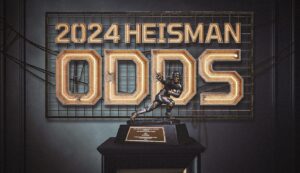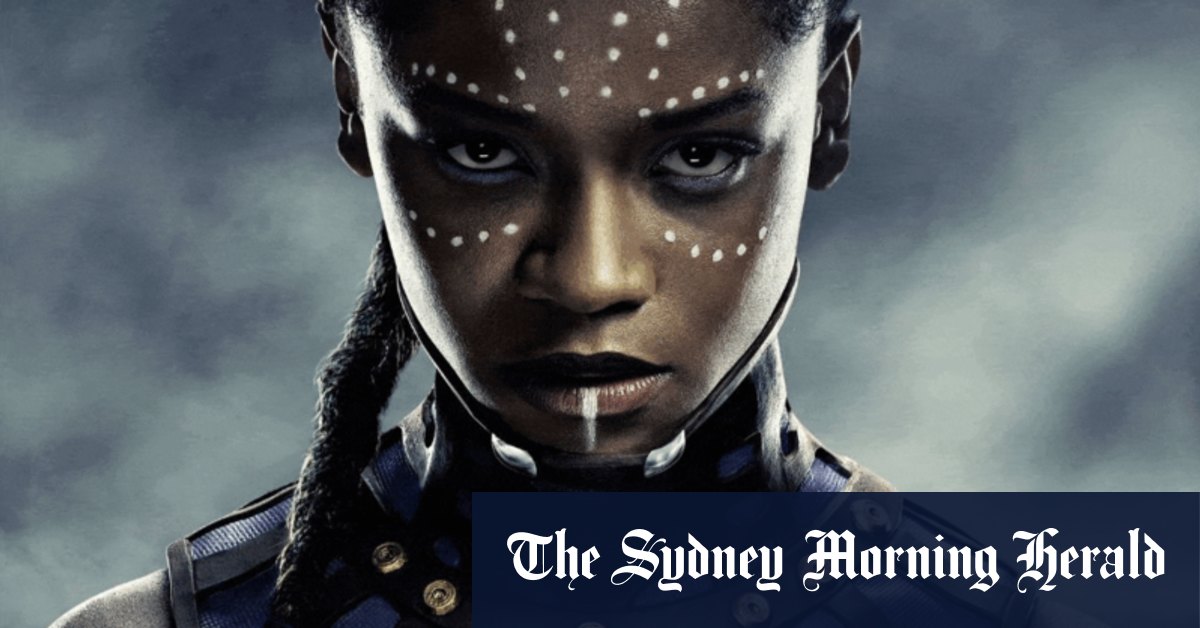
One of the great disappointments of living in the future is how backwards-looking it can feel. The richest tech bros of Silicon Valley are chasing the same dreams that excited science fiction readers of the 1950s. Colonising Mars? Robot servants? Anyone still promising us these quaint fantasies is clearly selling something. Those flying cars will definitely be here by the next fiscal quarter, right?
The alternative to these naive visions is hardly preferable. The last few decades have seen science fiction flooded with dystopias, while actual science has been promising something not too different. From climate change to drone warfare to the internet turning us all into angry mobs, it’s grown increasingly hard to face the future with a smile on your face.
A new exhibition at ACMI looks to change all that. The Future and Other Fictions assembles 180 works that dare to imagine tomorrows both hopeful and possible. From Bjork’s ecstatic visions uniting the organic and the artificial, to the Afrofuturism of the Black Panther films, to emerging artists serving up worlds unlike any you’ve seen before, it aims to give visitors the tools to rethink their own future.
The show, with side programs including discussions, workshops and performances, is curated by ACMI’s Amanda Haskard and Chelsey O’Brien and filmmaker and futurist Liam Young. When a previous ACMI exhibition asked patrons to draw their vision of the future, O’Brien noticed how often people would fall back on a limited set of tropes. “It’s flying cars, it’s skyscrapers, it’s corporations. It’s a very traditional kind of sci-fi, really. So that was something that we wanted to rethink: hang on a minute, is that also very Western, very white, very masculine?”
Haskard says visions of the future that don’t fall back on the cliches of space opera or post-apocalyptic wastelands often come from people for whom the future has always meant something else. As a Gunai/Kurnai woman, she knows well the alternative understandings of time that can come from First Nations experiences. “When you think of the concept of Indigenous futurisms, as Blackfellas or First Nations people we’ve actually been living in the apocalypse since colonisation.”
For many artists, she says, imagining a future with themselves in it is already a radical act. The exhibition includes costumes from the 2022 superhero film Black Panther: Wakanda Forever, which, says Haskard, “imagines a world that hasn’t been colonised. That is a beautiful imagining.”
The film’s costume designer, Ruth E. Carter, was, says O’Brien, “brought on to a massive Disney blockbuster film and said OK, I really want to make sure that I can see my culture within this”.
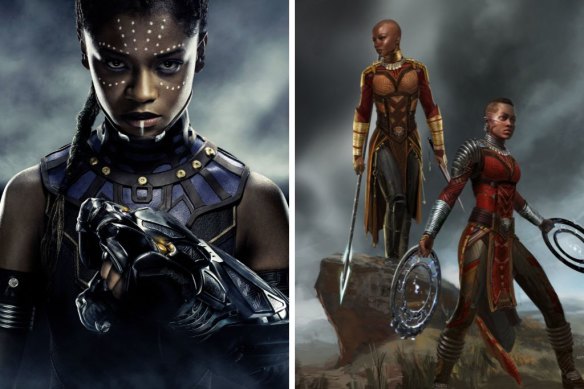
The Future and Other Fictions exhibition includes Ruth E. Carter’s costumes for Black Panther: Wakanda Forever.
Elsewhere in the show, Osheen Siva, a Dalit and Tamil artist living in Goa, imagines beings that seem equal parts gods, monsters, space-farers and superheroes. They’re celebratory and infused with motion, but there’s also a political edge to them.
What Siva refers to as their “counter-mythology” reworks sacred iconography to resist its more confining implications. “A huge part of the caste system is based on Hindu scripture and this idea of good versus evil, light versus dark, and the very obvious association there is that the upper caste is associated with the good and we are associated with the rest of it. It’s interesting for me to create worlds that are counter to this,” they say.
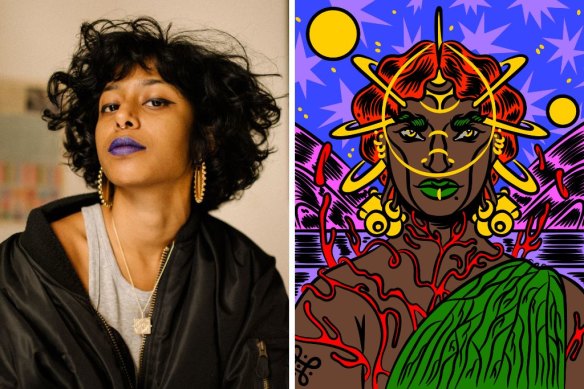
Artist Osheen Siva reworks sacred iconography in the Tamil Futures series.Credit: ACMI
Siva’s imagery escapes the limiting stereotypes that typically surround India’s Dalit caste. “In general when we talk about anti-caste movements it’s usually about the struggles we go through. We just get portrayed as downtrodden, always looked down upon. When I was starting out it seemed kind of radical in its own way just to imagine us having a future in the first place. Imagining different ways of being, not just struggling. I think it’s important to highlight joys that exist within our community.”
Siva and Carter have both been inspired by Afrofuturism, and though their work is clearly very different, both promote the idea that the future can be what we make it, says O’Brien. “You don’t have to think that the future’s already written … If you want to make change you can.”
Her fellow curators emphasise that point: the show is designed in part to shift the relationship we all have with our own futures. Young says that we often get it backwards when one form of science fiction or another seems to become a reality. When mass surveillance took off, we tipped our hat to George Orwell. The robots that built your car? Isaac Asimov, author of the Robot series, among other forward-thinking works, saw that coming.
Loading
“But the opposite is the case,” says Young. “What people really do is see possibilities presented to them through these mediums of fiction, and then for better or worse they try to enact those futures.”
He cites the example of Jules Verne, whose pioneering novels gave scientists the impetus to create the technologies behind scuba tanks and submarines, and Mary Shelley’s Frankenstein, which has been named as an inspiration by the inventor of the pacemaker. A young Mae Jemison saw Star Trek’s Lieutenant Uhura onscreen as a child, and went on to become the first African-American woman in space.
Of course, not every example of speculative fiction has ended up providing the right kind of example. “The great tragedy of the contemporary tech industry is that a lot of the cautionary tales of science fiction that were written as warnings of what could happen become misread as blueprints for the future,” says Young.
“But it’s a call to arms, that idea. It suggests that what we better be doing is writing the right kinds of futures.”
You could argue that the last decade or so has seen the literary world trying to do just that. The rise of cli-fi – speculative fiction that imagines a future in which climate change runs rampant – is a call to make serious changes now.
“The idea … was that these kinds of dystopian visions … would scare us straight,” says Young. “If we saw just how bad it could get, then we would stop driving the SUVs, we would put on a sweater instead of turning up the heating, we would put the milk cartons in the right recycle bin.”
But dystopic visions can have the opposite effect, leaving us paralysed by a sense of powerlessness and inevitability.
“We desperately need new images of a climate future that aren’t cautionary tales but are hopeful road maps,” says Young.
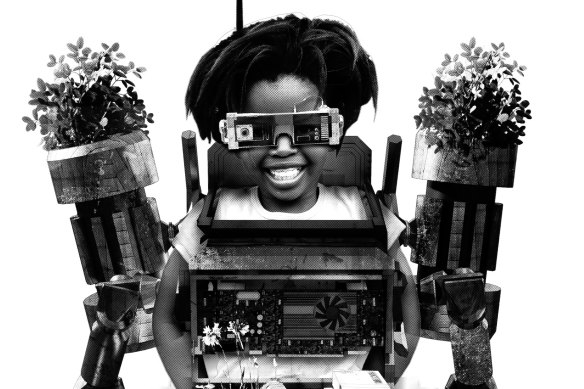
Olalekan Jeyifous, Anarchonauts Herbalist.Credit: ACMI
A case in point are the vivid imaginings of Nigerian-born, Brooklyn-based artist Olalekan Jeyifous, whose work re-figures shanty towns and ghettoes as vivid, flourishing spaces bursting with life, re-wilded and full of resources.
“He has a very powerful storytelling ability and speculative practice that really flips the script,” says Haskard.
Then there’s Bjork, whose practice across various forms of media has long been animated by a fascination with cyborgs, mutants, shape-shifters and the endlessly changing natural world. The iridescent, many-layered dress she wore for her music video/short film The Gate will welcome visitors to the ACMI show.
“Bjork talks about The Gate as this post-apocalyptic vision of what her utopia is,” says Haskard. “It’s about love as resistance, which is so beautiful. And I’ve always seen Bjork as a real environmental activist. Nature has always been woven into her works, really inspired by plants, flowers, fungi. She describes the dress as a light of hope in the dark. A beautiful way to start to imagine what the future is.”

Bjork’s orchid dress will be on display at ACMI’s The Future and Other Fictions exhibition.
You might not think of Bjork’s work as science fiction, but that might say something about the label itself.
“We’ve looked at the sci-fi renegades,” says Haskard. “Acknowledging science fiction, but also that sense of resistance. We steered away from science fiction, and it’s not a science fiction show. It’s very much about speculative fiction, ideas on screen. That’s one of the key messages, so people are not coming to ACMI expecting to see Star Wars.”
While Young’s own work has seen him described as a futurist, it’s not always a term he employs himself. “There’s a particular brand of futurism that exists in the corporate space which is aligned with an insidious form of marketing, trend-spotting and so on which is somehow about how you monetise a particular view of the future. I’m less interested in that.”
At the same time, he says, perhaps we should all start thinking of ourselves as futurists. “At this point in time if any one of us isn’t thinking about the long-term consequences of what we’re doing then we’re really in trouble. We’re in a moment where everyone needs to be a futurist somehow.”
A major thesis guiding The Future and Other Fictions is that popular culture helps us build our visions of the shape of things to come. If our ability to dream of the future has atrophied, it’s because our cultural diet has been too narrow.
“If we close our eyes and imagine what we think of as a hopeful or aspirational future, everyone would kind of sketch out the same sort of thing,” says Young. “It would be this image of a city with trees on rooftops and little community gardens. This return to localism, a rejection of the global, getting up at sunrise and milking the chickens or whatever. It’s a particular idea of the future that came out of the narratives and stories of the ’60s and ’70s, back to a very particular kind of environmentalism.”
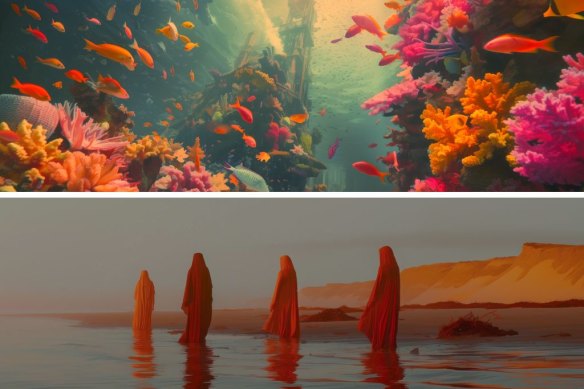
Concept illustrations for After the End, directed by Liam Young, written by Natasha Wanganeen, VFX supervisor Alexey Marfin. Credit: Courtesy of the artists
You won’t find any of that in Young’s works, which present jaw-dropping cityscapes and architectural marvels that eschew the nostalgia of so much science fiction. “They don’t look like trees on rooftops. They look like planetary-scaled infrastructure of carbon removal. They look like the decommissioning of mega-scaled fossil fuel infrastructure,” he says.
“A lot of the images that operate at that scale, that talk about planetary movements of change, up until now in the history of popular culture were seen as the work of the Bond villain or the evil mega-corporation. So what we need is this massive generational paradigm shift where we start to embrace new kinds of images.”
“We’re not trying to present the answers,” says Haskard. “The show presents … alternative stories across the whole spectrum of screen culture. We’ve got video games, commissioned works, moving image art, film, TV. It’s showcasing the ability of creators to reshape our thinking about what the future can be.”
It’s a diverse and democratic undertaking that ultimately hopes to give audiences the tools to imagine a future for themselves. After all, says O’Brien, “the future is easy to write off if we don’t see ourselves in it”.
The Future and Other Fictions is at ACMI from November 28.



